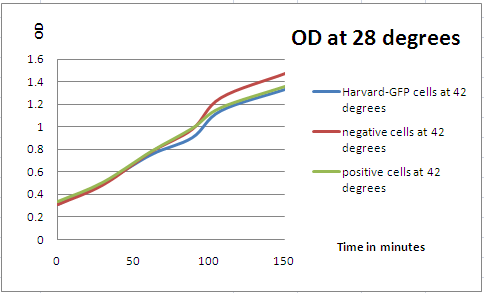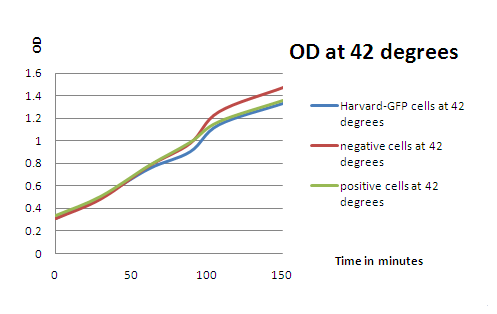Team:Imperial College London/Wetlab/Results/Thermoinduction
From 2009.igem.org
(→Absorbance data) |
(→Absorbance data) |
||
| Line 8: | Line 8: | ||
=Absorbance data= | =Absorbance data= | ||
Understanding of the fluorescence data requires normalization with cell growth data, in the form of optical density (absorbance). | Understanding of the fluorescence data requires normalization with cell growth data, in the form of optical density (absorbance). | ||
| - | ==28 degrees Celsius== | + | ===28 degrees Celsius=== |
[[Image:II09_28degs.jpg]]<br> | [[Image:II09_28degs.jpg]]<br> | ||
<b>Figure 1: Absorbance at 28 degrees Celsius </b> | <b>Figure 1: Absorbance at 28 degrees Celsius </b> | ||
| - | ==42 degrees Celsius== | + | ===42 degrees Celsius=== |
[[Image:II09_42deg.jpg]]<br> | [[Image:II09_42deg.jpg]]<br> | ||
<b>Figure 2: Absorbance at 42 degrees Celsius </b><br> | <b>Figure 2: Absorbance at 42 degrees Celsius </b><br> | ||
| - | Plotting raw absorbance data on its own does not provide sufficient information about the effects of temperature on our system. Therefore, further analysis is required. This includes recording the variation in absorbance of the blank well (containing only the M9 medium) and normalizing absorbance data against the latter to spot ay possible trends in growth rate variations at different temperatures. | + | Plotting raw absorbance data on its own does not provide sufficient information about the effects of temperature on our system. Therefore, further analysis is required. This includes recording the variation in absorbance of the blank well (containing only the M9 medium) and normalizing absorbance data against the latter to spot ay possible trends in growth rate variations at different temperatures. |
| + | |||
=Growth rate for different blank medium levels= | =Growth rate for different blank medium levels= | ||
{{Imperial/09/TemplateBottom}} | {{Imperial/09/TemplateBottom}} | ||
Revision as of 22:48, 20 October 2009

Contents |
Experiment Rationale
To investigate the behaviour of the lamda-cI thermoinducible construct and show that when temperature is low (at 28 degrees Celsius), there is low fluorescence output. This shows that the genome deletion module is repressed. When temperature is raised to 42 degrees Celsius, fluorescence increases, indicating that the repression is lifted. We are looking at both absorbance and fluorescence data.
Absorbance data
Understanding of the fluorescence data requires normalization with cell growth data, in the form of optical density (absorbance).
28 degrees Celsius

Figure 1: Absorbance at 28 degrees Celsius
42 degrees Celsius

Figure 2: Absorbance at 42 degrees Celsius
Plotting raw absorbance data on its own does not provide sufficient information about the effects of temperature on our system. Therefore, further analysis is required. This includes recording the variation in absorbance of the blank well (containing only the M9 medium) and normalizing absorbance data against the latter to spot ay possible trends in growth rate variations at different temperatures.
Growth rate for different blank medium levels
 "
"



